On June 4, the Ethereum Foundation (EF) officially released its latest "Treasury Management Policy," which systematically outlines its financial expenditure policies, asset allocation strategies, and the long-term vision of "Defipunk." This policy aims to enhance the financial resilience of the foundation, support DeFi innovation, and strengthen its value stance on privacy protection and self-custody.
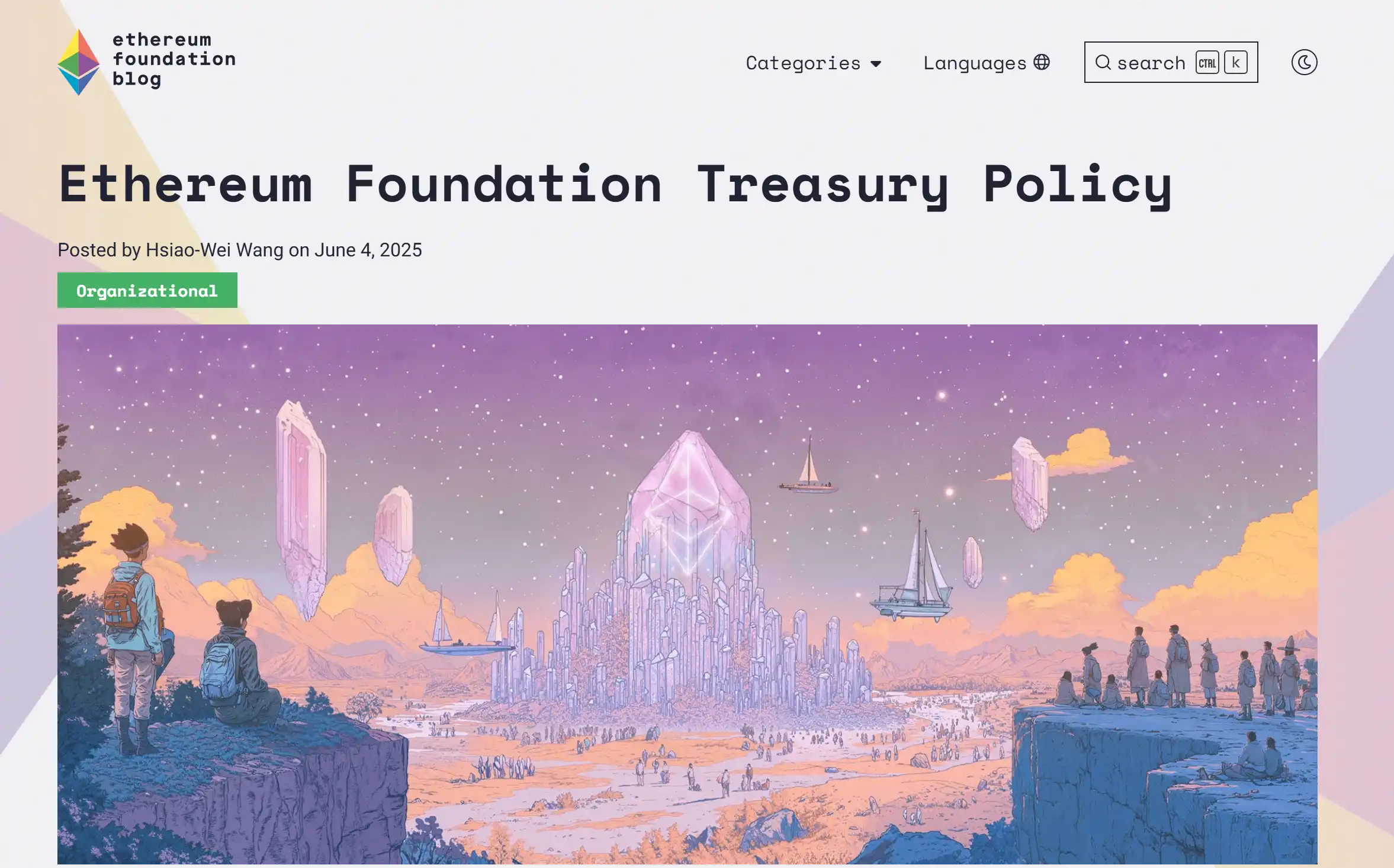
Ethereum Foundation's "Treasury Management Policy" page
The role of the EF treasury is to support the foundation's long-term autonomy, sustainability, and legitimacy. The Ethereum Foundation (EF) is expected to continue as the long-term steward of the ecosystem, but its scope of responsibilities will gradually narrow.
Increase in fiat reserves, heavy investment in product delivery
According to the new policy, EF will determine the allocation ratio of fiat and ETH using the "operating expenditure ratio × buffer years" model, maintaining annual expenditures at a high level of 15%. The foundation pointed out that 2025-2026 will be a critical phase for the ecosystem, requiring a concentration of resources to advance the technical implementation at the protocol layer, including L1 scaling, blob technology, and UX optimization.
EF stated that 2025-2026 will be a key window for advancing protocol implementation, expecting to maintain 15% annual expenditure and set a 2.5-year fiat buffer period. This means the foundation needs to convert about 37.5% of its treasury into fiat to support medium- to short-term investments.

According to the new "Treasury Management Policy" released by EF, A represents annual operating expenditure (as a percentage of the current total treasury), and B represents the operating buffer years (the number of years the reserves can support operations)
Specifically, this model logic can be broken down into three levels, corresponding to strategy formulation, amount calculation, and execution.
First Level: Structural Model, Setting Asset Allocation Ratios
The foundation first uses a structural model to determine its asset allocation framework. This model calculates the target fiat ratio by multiplying the annual operating expenditure as a percentage of the treasury (A) by the desired operating buffer years (B):
A × B: Determines the target reserve size in fiat. This value dictates the frequency and scale of ETH sales.
This level of the model does not focus on specific amounts but emphasizes how the foundation should maintain a long-term asset structure, reducing the pressure of short-term decision-making caused by price fluctuations, applicable to the formulation of governance frameworks or asset allocation policies.
According to data disclosed in the "2024 Ethereum Foundation Report," the total value of the Ethereum Foundation treasury is $970.2 million, a decrease of 39% from the last disclosure. Of this, the operating expenditure for 2023 is approximately $134.9 million, accounting for 13.9% of the total treasury value.
Based on the new fiscal standard of 15% annual operating expenditure and a 2.5-year buffer period, EF's target fiat reserve ratio is 15% × 2.5, which equals 37.5%. Currently, the foundation's cryptocurrency asset ratio is as high as 81.3%, under the new standard, the foundation may need to reduce its ETH holdings by nearly 30%.
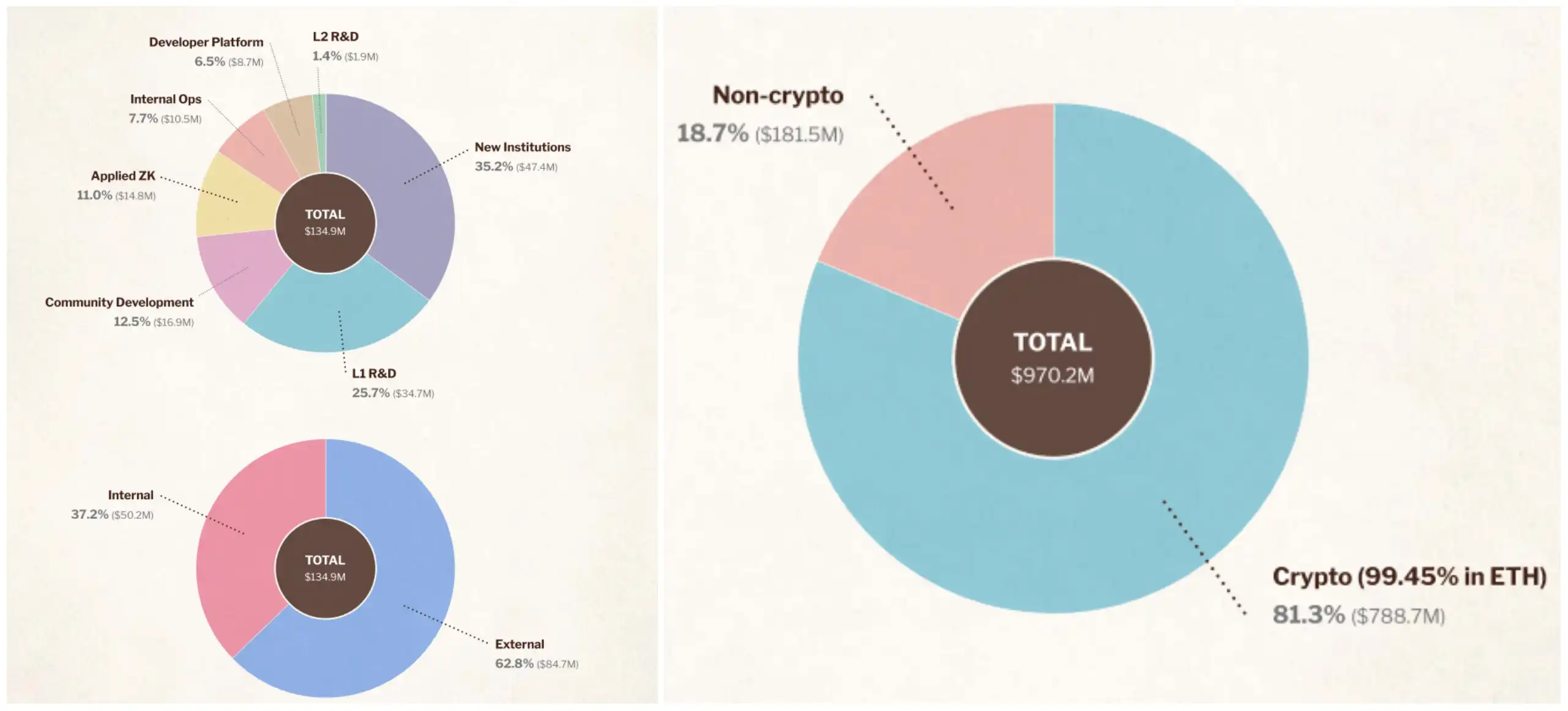
According to EF's financial report, the classification of the Ethereum Foundation's operating expenditures for the 2023 fiscal year (left) and the asset allocation ratio (right), under the new fiscal standard, EF needs to reduce its cryptocurrency asset holdings by nearly 30%.
Second Level: Amount Model, Calculating How Much Fiat to Raise
After setting the structural ratio, the foundation applies the target ratio to the current total treasury value, converting it into a specific fundraising target:
Target Fiat Reserve = A × B × Current Total Treasury Value
In actual amounts, the target fiat reserve is approximately $363 million. This amount model is used to assess whether the current fiat reserves are sufficient and whether ETH needs to be sold to raise the difference, serving as an important basis for decision-making at the execution level.
Third Level: Execution Model, Back-Calculating How Much ETH to Hold
Finally, to implement the allocation targets for fiat and ETH, the foundation will treat the remaining treasury portion (i.e., 1 - A × B) as the value of ETH reserves and divide it by the current ETH price to back-calculate the amount of ETH that should be held:
Total Treasury - A × B: This is the target value of ETH reserves (divided by the ETH price to obtain the core amount of ETH held).
Target ETH Amount = (1 - A × B) × Total Treasury ÷ Current ETH Price
This step translates the strategic model into actual holding requirements. In terms of actual amounts, with a treasury of $970 million, A × B = 37.5%, and assuming an ETH price of $2,500, the foundation should retain approximately 242,000 ETH as core long-term holding assets.
Compared to traditional budgeting systems, this model provides a more flexible asset allocation approach: it allows for timely conversion to fiat during bull markets, enhancing cyclical resilience; during market downturns, it can maintain a long-term holding belief. EF stated that the board will regularly evaluate parameters A and B to dynamically adjust the asset structure, ensuring resource allocation aligns with strategic rhythms.
The next two and a half years are viewed by the Ethereum Foundation as a critical period for the ecosystem, necessitating a concentration of resources to advance important technical deliveries. In 2025, EF will spend approximately 15% of treasury funds (with a fiat reserve ratio of 37.5%) and plans to maintain a statutory buffer for 2.5 years of expenditures. It also plans to gradually reduce annual operating expenditures linearly over the next five years, ultimately reaching a long-term baseline level of 5%.
Related Reading: "Ethereum Foundation's 2030 Plan: Reducing ETH Expenditure to 5%, Actively Supporting Defipunk"
Optimizing Asset Management, Emphasizing RWA Quotas
In terms of asset allocation, the Ethereum Foundation (EF) has further clarified its asset allocation framework in the new policy, aiming to balance security, liquidity, and long-term robustness.
Regarding cryptocurrency assets, EF stated that it will seek stable financial returns without violating the principles of Ethereum's decentralization and openness. The foundation prioritizes deployment to audited, permissionless, and transparently structured DeFi protocols, emphasizing the prevention of potential risks related to smart contracts, governance, stablecoins, and oracles, while avoiding excessive pursuit of high-risk returns.
On-chain funds will be flexibly allocated based on market conditions, risk exposure, and return opportunities, currently including independent staking and providing wETH liquidity to mainstream lending protocols. In the future, it also plans to introduce stablecoin lending and some high-security on-chain RWA products as supplements. Additionally, EF will evaluate the deviation between actual fiat reserves and operational buffer targets quarterly to decide whether to sell ETH and make strategic choices between off-chain exchanges or on-chain swaps.
Compared to previous strategies focused on on-chain returns, EF has explicitly introduced tokenized real-world assets (Tokenized RWAs) as an important component of fiat assets. Its allocation structure is divided into three layers: immediate liquid assets for daily expenditures, low-risk assets matching medium- to long-term obligations, and tokenized real-world assets (Tokenized RWAs) included in a unified strategic management system.
This change sends a clear signal: the foundation is beginning to consider robust return tools from the fiat world more, aiming to support the sustainability of higher short- to medium-term expenditures, rather than relying on market conditions or the randomness of on-chain returns.
It is worth noting that only RWA protocols that meet conditions of on-chain transparency, auditability, and decentralized governance may be included in the foundation's system. In contrast, traditional RWA projects that are structurally closed and rely on legal trust paths will face higher thresholds.
Such adjustments not only enhance the robustness of the treasury structure but also reserve institutional space for further expanding on-chain asset management paths. Currently, relevant deployment details have not been disclosed.
Issuing "New Standards for Entrepreneurship" in Ecological Projects
In addition, EF has proposed clear Cypherpunk goals in its new fiscal policy and has built an evaluation framework called "Defipunk" based on this, aiming to promote the construction of more decentralized, privacy-friendly, and technology-independent financial infrastructure. This framework emphasizes six core values: security, open source, financial autonomy, technology replacing trust, cryptographic tools safeguarding freedom, and privacy protection, with a particular focus on the privacy of transactions and on-chain data.
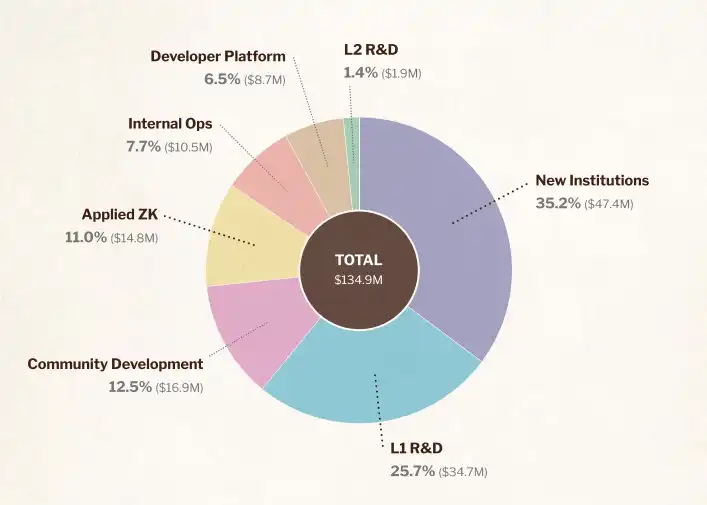
The flow of EF's operating expenditures for the 2023 fiscal year, most of which went into L1 underlying research and the establishment of "new institutions." Following EF's announcement of layoffs and strategic direction adjustments, expenditures in these areas may significantly decrease.
At the same time, EF has developed a standardized evaluation system applicable to future on-chain deployments. This includes whether there is permissionless access, self-custody capability, FLOSS-level open-source protocols, privacy protection options, publicly transparent development and governance processes, trust-minimized core logic, manipulation-resistant oracle mechanisms, security audit guarantees, and decentralized user interaction interfaces. EF stated that this evaluation framework will serve as an important reference standard for future treasury fund deployments, encouraging ecological projects to continuously optimize in terms of security, privacy, and decentralization, thereby jointly building a long-term financial ecosystem that aligns with crypto-native values.
The Defipunk framework will influence the Ethereum Foundation's funding mechanisms for developers, particularly regarding privacy, as EF explicitly views privacy as a future focus, emphasizing support for concealed transactions, data protection mechanisms, and decentralized user interfaces, while encouraging on-chain anonymous operations. The foundation stated, "Privacy is a key unfinished task for DeFi," and will promote the development of related ecosystems through strategic funding and research collaboration. This shift in stance may bring new funding inflows and long-term endorsements for privacy protocols like Railgun and anonymous identity projects.
This policy framework, equipped with public standards and evaluation mechanisms, marks the quiet departure of an era heavily reliant on the subjective judgments of core members. For a long time, projects seeking "legitimacy" recognition within the Ethereum ecosystem often had to establish connections with EF through informal channels. Whether project founders sought endorsement or investment institutions aimed to engage with quality targets early, EF researchers were seen as key nodes to access resources and discourse power. This interpersonal network-dominated ecological operation model made "getting close to EF" an unavoidable path to success.
Related Reading: 《EF Has No Dreams》
In this context, the evaluation framework of "Defipunk" launched by EF is particularly significant. It is not only a technical explanation of the rules for fund usage but also marks a shift in ecological governance philosophy—from "consensus politics" driven by implicit power networks to a transparent mechanism based on public standards and value orientation.
The Defipunk evaluation system, centered on security, decentralization, and privacy protection, provides a clearer institutional path for future projects to obtain funding support and ecological recognition. In other words, from now on, whether a project can receive support will no longer depend solely on "who they know," but rather on whether it aligns with Ethereum's long-term vision and public value goals.
This represents a loosening at the institutional level and is an important starting point for the ecological culture to return from personal preferences to technical rationality.
Community Reactions: Has ETH Hit Bottom?
As the Ethereum Foundation released its new fiscal policy and proposed the goal of "cost reduction and efficiency improvement," a series of noteworthy movements have also emerged in the market. Internal personnel adjustments within the foundation, strategic bets on ETH in the capital market, and a temporary rebound in the ETH/BTC exchange rate intertwine to create a more complex ecological structure. The community has engaged in extensive discussions, with opinions resonating between consensus and divergence.
On June 3, EF announced the layoff of some research personnel and restructured the original research team into a new department called "Protocol," focusing resources on three major technical directions: L1 scaling, blob expansion, and UX improvement. The official positioning of this move is as an optimization of resource allocation; on one hand, it involves laying off some research personnel, particularly those teams that have long remained in the theoretical stage; on the other hand, it introduces a stricter accountability mechanism, requiring rapid transformation of research results into actual outputs. Co-Executive Director Hsiao-Wei Weng stated on social media X that he hopes the new structure can drive core projects to progress more efficiently.
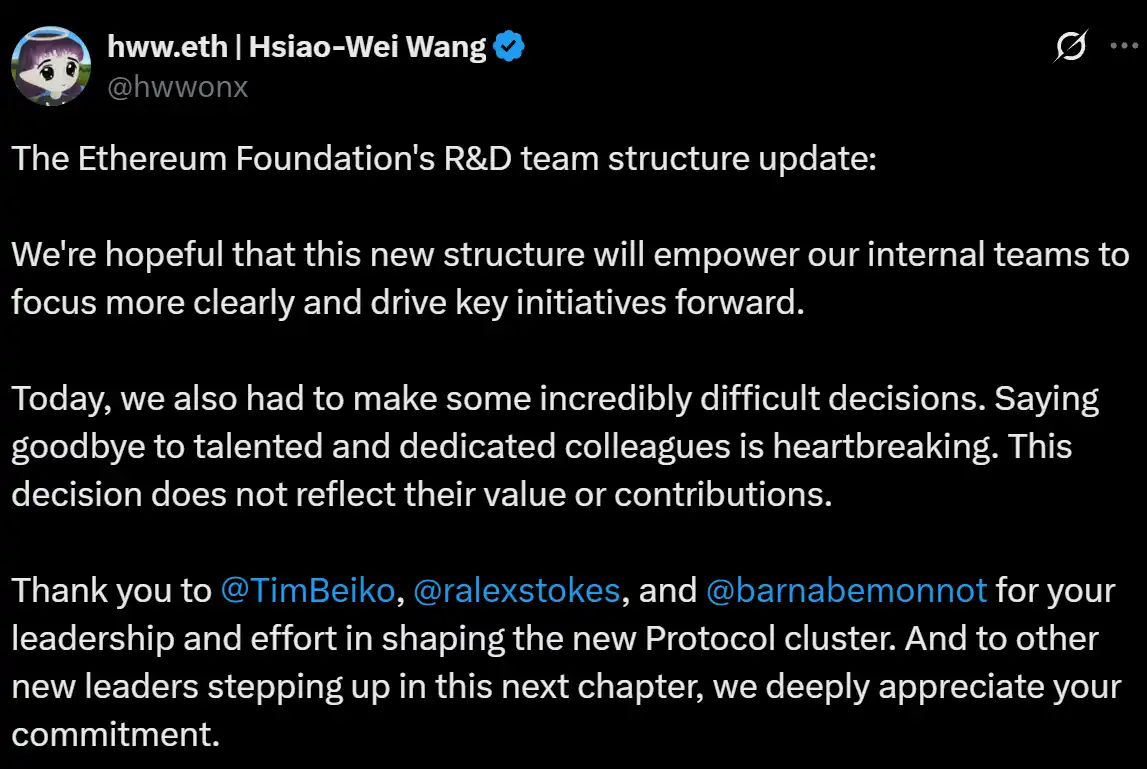
Previously, the criticism of the Ethereum Foundation (EF) had been prolonged, and the weak performance of Ethereum over the past few months has further fueled community dissatisfaction. Many prominent investors and developers have expressed their opinions and discontent with EF, and some core members have left EF, redirecting their research and resources outside the foundation, indicating that internal divisions within EF have reached an irreconcilable point, pushing EF directly into the spotlight.

Related Reading: 《Core Members Leave to Establish "Copycat EF," How Long Can the Ethereum Foundation Last?》
As a result, some voices in the community view the restructuring of the Ethereum Foundation as a "self-correction" in response to external criticism. Other developers point out that this is a necessary focus adjustment, expected to concentrate more power on the core evolution of the protocol layer.

Almost simultaneously, the US-listed company SharpLink Gaming announced its Ethereum treasury reserve strategy, planning to raise $425 million for long-term ETH holdings, with the leading investor being Consensys, an important technical driver in the Ethereum ecosystem. This operation, referred to as the "ETH version of MicroStrategy," is interpreted in the community as a repricing of Ethereum by traditional capital markets and is seen as Consensys publicly endorsing its technical route.
SharpLink's large bet quickly boosted market confidence; after the announcement on May 28, the ETH price rose 4% within 24 hours, reaching $2,639, with a cumulative increase of 50% over the past month.
Related Reading: 《Spending $425 Million on the ETH Version of MicroStrategy, "E Guardians" Abandon Political Correctness》
On June 4, the ETH/BTC exchange rate rose over 2% in a short period, drawing market attention to the direction of capital allocation. Traders viewed this as a signal of ETH's relative value returning. Some analysts believe that ETH is currently approaching a large technical formation's peak area, and if it breaks through successfully, the price could rise to $2,000 or $3,000, driven either by fundamental improvements or merely by the entry of large capital.
Related Reading: 《10x Research: ETH's Performance is More Resilient than Expected, Approaching a Key Technical Formation Peak》
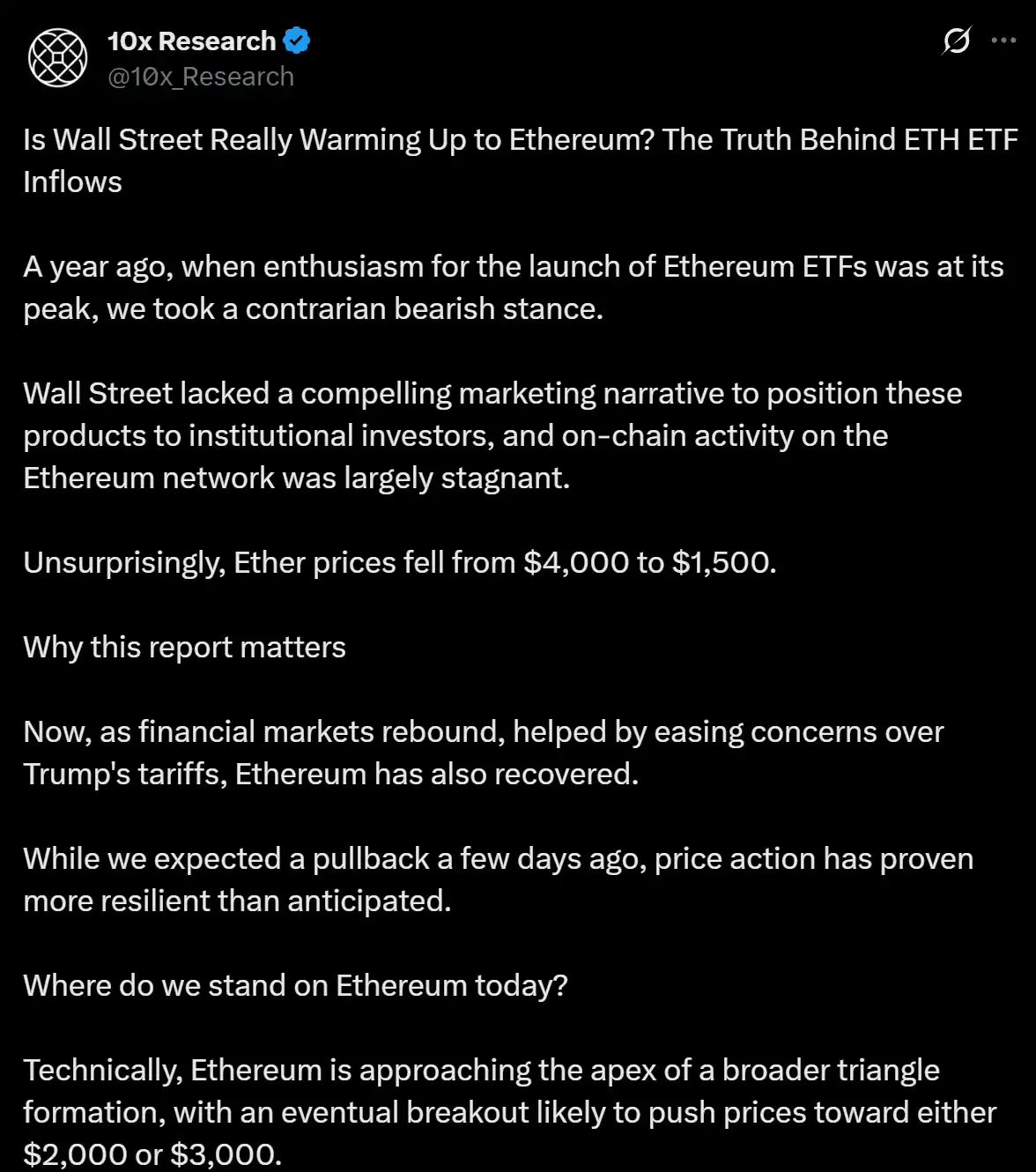
However, it is more noteworthy that, in contrast to the foundation's reduction of operating expenses and the market's high-profile accumulation of ETH, the narrative focus of Ethereum is shifting from "institutional incentives" to "market consensus," with the tension between technological promotion and capital will being played out simultaneously.
Overall, EF's current strategy of cost reduction and efficiency improvement is both a manifestation of fiscal prudence and reflects its redefinition of its role boundaries. In the context of the ongoing evolution of decentralized governance, the collaborative relationships among the foundation, technology companies, capital institutions, and developer communities are moving toward a more complex but potentially more efficient new phase.
免责声明:本文章仅代表作者个人观点,不代表本平台的立场和观点。本文章仅供信息分享,不构成对任何人的任何投资建议。用户与作者之间的任何争议,与本平台无关。如网页中刊载的文章或图片涉及侵权,请提供相关的权利证明和身份证明发送邮件到support@aicoin.com,本平台相关工作人员将会进行核查。




